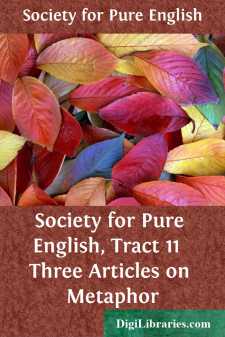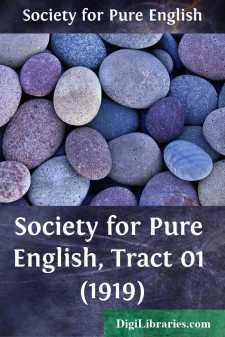Categories
- Antiques & Collectibles 13
- Architecture 36
- Art 48
- Bibles 22
- Biography & Autobiography 813
- Body, Mind & Spirit 142
- Business & Economics 28
- Children's Books 17
- Children's Fiction 14
- Computers 4
- Cooking 94
- Crafts & Hobbies 4
- Drama 346
- Education 46
- Family & Relationships 57
- Fiction 11829
- Games 19
- Gardening 17
- Health & Fitness 34
- History 1377
- House & Home 1
- Humor 147
- Juvenile Fiction 1873
- Juvenile Nonfiction 202
- Language Arts & Disciplines 88
- Law 16
- Literary Collections 686
- Literary Criticism 179
- Mathematics 13
- Medical 41
- Music 40
- Nature 179
- Non-Classifiable 1768
- Performing Arts 7
- Periodicals 1453
- Philosophy 64
- Photography 2
- Poetry 896
- Political Science 203
- Psychology 42
- Reference 154
- Religion 513
- Science 126
- Self-Help 84
- Social Science 81
- Sports & Recreation 34
- Study Aids 3
- Technology & Engineering 59
- Transportation 23
- Travel 463
- True Crime 29
Society for Pure English, Tract 11 Three Articles on Metaphor
Categories:
Description:
Excerpt
I. NOTES ON THE FUNCTION OF METAPHOR
The business of the writer is to arouse in the mind of his reader the fullest possible consciousness of the ideas or emotion that he is expressing.
To this end he suggests a comparison between it and something else which is similar to it in respect of those qualities to which he desires to draw attention. The reader's mind at once gets to work unconsciously on this comparison, rejecting the unlike qualities and recognizing with an enhanced and satisfied consciousness the like ones. The functions of simile and metaphor are the same in this respect.
Both simile and metaphor are best when not too close to the idea they express, that is, when they have not many qualities in common with it which are not cogent to the aspect under consideration.
The test of a well-used metaphor is that it should completely fulfil this function: there should be no by-products of imagery which distract from the poet's aim, and vitiate and weaken the desired consciousness.
A simile, in general, need not be so close as a metaphor, because the point of resemblance is indicated, whereas in a metaphor this is left to the reader to discover.
When a simile or metaphor is from the material to the immaterial, or vice versa, the analogy should be more complete than when it is between two things on the same plane: when they are on different planes there is less dullness (that is, less failure to produce consciousness), and the greater mental effort required of the reader warrants some assistance.
The degree of effort required in applying any given metaphor should be in relation to the degree of emotion proper to the passage in which it is used. Only those metaphors which require little or no mental exertion should be used in very emotional passages, or the emotional effect will be much weakened: a far-fetched, abstruse metaphor or simile implies that the writer is at leisure from his emotion, and suggests this attitude in the reader.—[E.B.]
II. SOME NOTES ON METAPHOR IN JOURNALISM
Live and dead metaphor; some pitfalls; self-consciousness and mixed metaphor.
1. Live and Dead Metaphor.
In all discussion of metaphor it must be borne in mind that some metaphors are living, i.e. are offered and accepted with a consciousness of their nature as substitutes for their literal equivalents, while others are dead, i.e. have been so often used that speaker and hearer have ceased to be aware that the words are not literal: but the line of distinction between the live and the dead is a shifting one, the dead being sometimes liable, under the stimulus of an affinity or a repulsion, to galvanic stirrings indistinguishable from life. Thus, in The men were sifting meal we have a literal use of sift; in Satan hath desired to have you, that he may sift you as wheat, 'sift' is a live metaphor; in the sifting of evidence, the metaphor is so familiar that it is about equal chances whether sifting or examination will be used, and a sieve is not present to the thought—unless, indeed, some one conjures it up by saying All the evidence must first be sifted with acid tests, or with the microscope; under such a stimulus our metaphor turns out to have been not dead, but dormant....






